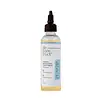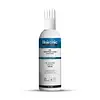What's inside
What's inside
 Key Ingredients
Key Ingredients

 Benefits
Benefits

 Concerns
Concerns

 Ingredients Side-by-side
Ingredients Side-by-side

Water
Skin ConditioningHamamelis Virginiana Water
AstringentHamamelis Virginiana Extract
AntiseborrhoeicPropylene Glycol
HumectantZinc Chloride
AntimicrobialHydrolyzed Wheat Protein
Skin ConditioningCinnamomum Zeylanicum Bark Extract
AntimicrobialThymus Vulgaris Extract
PerfumingMalva Sylvestris Flower/Leaf/Stem Extract
Skin ConditioningHamamelis Virginiana Leaf Extract
Skin ConditioningTriethanolamine
BufferingVitis Vinifera Seed Extract
AntimicrobialLactic Acid
BufferingSalicylic Acid
MaskingPhenoxyethanol
PreservativeEthylhexylglycerin
Skin ConditioningHydrolyzed Soy Protein
HumectantHydrolyzed Corn Protein
Skin ConditioningXanthan Gum
EmulsifyingSodium Gluconate
Skin ConditioningRapeseed Sophorolipids
AntimicrobialPisum Sativum Sprout Extract
Skin ConditioningSodium Benzoate
MaskingGlycerin
HumectantPhosphatidylcholine
EmulsifyingDisodium Phosphate
BufferingBiotin
AntiseborrhoeicPotassium Phosphate
BufferingCetrimonium Chloride
AntimicrobialTocopherol
AntioxidantDisodium EDTA
Tocopheryl Acetate
AntioxidantWater, Hamamelis Virginiana Water, Hamamelis Virginiana Extract, Propylene Glycol, Zinc Chloride, Hydrolyzed Wheat Protein, Cinnamomum Zeylanicum Bark Extract, Thymus Vulgaris Extract, Malva Sylvestris Flower/Leaf/Stem Extract, Hamamelis Virginiana Leaf Extract, Triethanolamine, Vitis Vinifera Seed Extract, Lactic Acid, Salicylic Acid, Phenoxyethanol, Ethylhexylglycerin, Hydrolyzed Soy Protein, Hydrolyzed Corn Protein, Xanthan Gum, Sodium Gluconate, Rapeseed Sophorolipids, Pisum Sativum Sprout Extract, Sodium Benzoate, Glycerin, Phosphatidylcholine, Disodium Phosphate, Biotin, Potassium Phosphate, Cetrimonium Chloride, Tocopherol, Disodium EDTA, Tocopheryl Acetate
Propylene Glycol
HumectantPolysorbate 80
EmulsifyingSalicylic Acid
MaskingCetrimonium Chloride
AntimicrobialAloe Barbadensis Leaf Extract
EmollientOryza Sativa Extract
AbsorbentPolyquaternium-10
Polyquaternium-7
Panthenol
Skin ConditioningParfum
MaskingPhenoxyethanol
PreservativeLinum Usitatissimum Seed Extract
PerfumingVitis Vinifera Seed Extract
AntimicrobialCamellia Sinensis Leaf Extract
AntimicrobialXanthan Gum
EmulsifyingHydroxyethylcellulose
Emulsion StabilisingWater
Skin ConditioningPropylene Glycol, Polysorbate 80, Salicylic Acid, Cetrimonium Chloride, Aloe Barbadensis Leaf Extract, Oryza Sativa Extract, Polyquaternium-10, Polyquaternium-7, Panthenol, Parfum, Phenoxyethanol, Linum Usitatissimum Seed Extract, Vitis Vinifera Seed Extract, Camellia Sinensis Leaf Extract, Xanthan Gum, Hydroxyethylcellulose, Water
Ingredients Explained
These ingredients are found in both products.
Ingredients higher up in an ingredient list are typically present in a larger amount.
This ingredient is a preservative, antimicrobial, and emulsifier. It is often used in cosmetics for its ability to cleanse, condition, and reduce static.
Cetrimonium chloride is a quaternary ammonium salt, meaning it has a water-soluble structure.
Phenoxyethanol is a preservative that has germicide, antimicrobial, and aromatic properties. Studies show that phenoxyethanol can prevent microbial growth. By itself, it has a scent that is similar to that of a rose.
It's often used in formulations along with Caprylyl Glycol to preserve the shelf life of products.
Propylene Glycol is an odorless, colorless liquid. As a humectant, it helps skin retain moisture. It also aids in delivering active ingredients.
Another role of this ingredient is preventing a product from melting or freezing. Propylene glycol also adds antimicrobrial properties to a product, elongating product lifespan.
This ingredient is considered an organic alcohol and commonly added into both cosmetics and foods.
Those with sensitive skin or conditions may develop a rash when using this ingredient.
Learn more about Propylene GlycolSalicylic Acid (also known as beta hydroxy acid or BHA) is a well-known ingredient for treating skin that struggles with acne and clogged pores. It exfoliates both the skin's surface and deep within the pores to help clear out buildup, control oil, and reduce inflammation.
Unlike AHAs (alpha hydroxy acids), salicylic acid is oil-soluble. This allows it to penetrate into pores which makes it especially effective for treating blackheads and preventing future breakouts.
Salicylic acid is also known for its soothing properties. It has a similar structure to aspirin and can calm inflamed or irritated skin, making it a good option for acne-prone skin that is also sensitive.
Concentrations of 0.5-2% are recognized by the U.S. FDA as an over-the-counter topical acne product.
It can cause irritation and/or dryness if one's skin already has a compromised moisture barrier, so it's best to focus on repairing that before introducing this ingredient into your routine.
While salicylic acid does not increase sun sensitivity, it’s still important to wear sunscreen daily to protect your skin.
If you are looking for the ingredient called BHA or Butylated Hydroxyanisole, click here.
Learn more about Salicylic AcidVitis Vinifera Seed Extract comes from the grape vine. Grape seeds are a byproduct of creating grape juice or wine.
The components of grape seeds have many skin benefits. Research has found it to be antimicrobial and anti-inflammatory. It also contains many potent antioxidants such as Vitamin E , Vitamin C, proanthocyanidins, polyphenols, flavonoids, and anthocyanins. Proanthocyanidin has been shown to help even out skin tone.
Antioxidants help fight free-radical molecules. Free-radical molecules are capable of damaging our cells and other genetic material. Antioxidants help stabilize free-radicals by donating extra electrons. Grape seed extract may help reduce the signs of aging.
The antimicrobial properties of grape seed may help treat acne. However, more research is needed to support this claim.
Grape seed has also been found to help absorb UV rays. Grape seed extract should not replace your sunscreen.
Learn more about Vitis Vinifera Seed ExtractWater. It's the most common cosmetic ingredient of all. You'll usually see it at the top of ingredient lists, meaning that it makes up the largest part of the product.
So why is it so popular? Water most often acts as a solvent - this means that it helps dissolve other ingredients into the formulation.
You'll also recognize water as that liquid we all need to stay alive. If you see this, drink a glass of water. Stay hydrated!
Learn more about WaterXanthan gum is used as a stabilizer and thickener within cosmetic products. It helps give products a sticky, thick feeling - preventing them from being too runny.
On the technical side of things, xanthan gum is a polysaccharide - a combination consisting of multiple sugar molecules bonded together.
Xanthan gum is a pretty common and great ingredient. It is a natural, non-toxic, non-irritating ingredient that is also commonly used in food products.
Learn more about Xanthan Gum